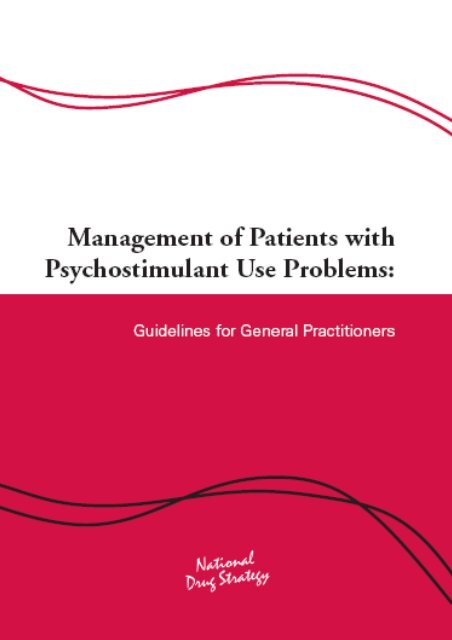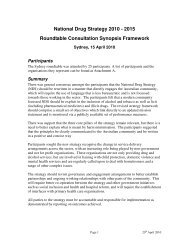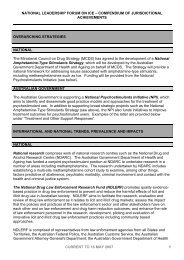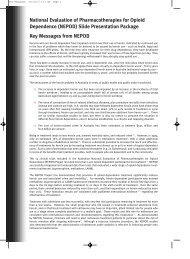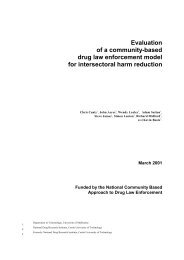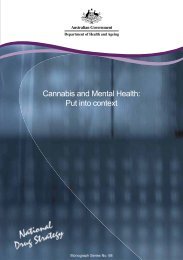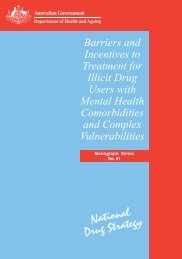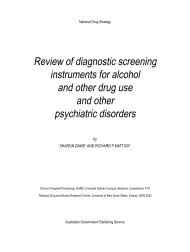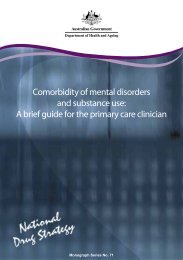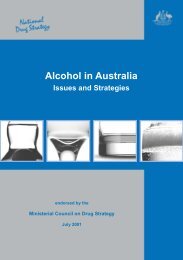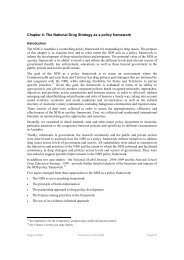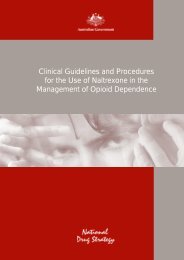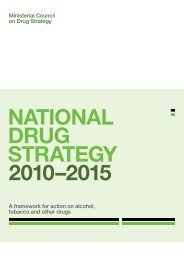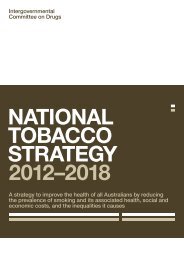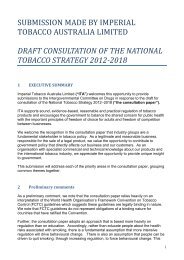Management of patients with psychostimulant use problems
Management of patients with psychostimulant use problems
Management of patients with psychostimulant use problems
Create successful ePaper yourself
Turn your PDF publications into a flip-book with our unique Google optimized e-Paper software.
<strong>Management</strong> <strong>of</strong> Patients <strong>with</strong><br />
Psychostimulant Use Problems:<br />
Guidelines for General Practitioners
© Commonwealth <strong>of</strong> Australia 2007<br />
ISBN: 1-74186-471-2<br />
Online ISBN: 1-74186-472-0<br />
Publications Number: P3 -2868<br />
Paper-based publications<br />
© Commonwealth <strong>of</strong> Australia 2007<br />
This work is copyright. Apart from any <strong>use</strong> as permitted under the Copyright Act<br />
1968, no part may be reproduced by any process <strong>with</strong>out prior written permission<br />
from the Commonwealth. Requests and inquiries concerning reproduction and<br />
rights should be addressed to the Commonwealth Copyright Administration,<br />
Attorney-General’s Department, Robert Garran Offices, National Circuit, Barton<br />
ACT 2600 or posted at http://www.ag.gov.au/cca<br />
Internet sites<br />
© Commonwealth <strong>of</strong> Australia 2007<br />
This work is copyright. You may download, display, print and reproduce this<br />
material in unaltered form only (retaining this notice) for your personal,<br />
non-commercial <strong>use</strong> or <strong>use</strong> <strong>with</strong>in your organisation. Apart from any <strong>use</strong> as<br />
permitted under the Copyright Act 1968, all other rights are reserved.<br />
Requests and inquiries concerning reproduction and rights should be<br />
addressed to Commonwealth Copyright Administration, Attorney-General’s<br />
Department, Robert Garran Offices, National Circuit, Barton ACT 2600 or<br />
posted at http://www.ag.gov.au/cca<br />
To request copies <strong>of</strong> this document, telephone National Mailing and Marketing on<br />
1800 020 103, extension 8654, or email nmm@nationalmailing.com.au<br />
Original Guidelines prepared by Linda Jenner, Amanda Baker, Ian Whyte and<br />
Vaughan Carr on behalf <strong>of</strong> the Guidelines Development Working Party (2004).<br />
Updated 2007 by Lesley Dawes and Meriel Schultz, Australian General Practice<br />
Network on behalf <strong>of</strong> the Guidelines Review Working Group.<br />
Suggested Citation: Australian General Practice Network. 2007. <strong>Management</strong><br />
<strong>of</strong> <strong>patients</strong> <strong>with</strong> <strong>psychostimulant</strong> <strong>use</strong> <strong>problems</strong> – Guidelines for general<br />
practitioners. Canberra. Australian Government Department <strong>of</strong> Health and Ageing<br />
The opinions expressed in this document are those <strong>of</strong> the authors and are not<br />
necessarily those <strong>of</strong> the Australian Government.<br />
ii<br />
MANAGEMENT OF PATIENTS WITH PSYCHOSTIMULANT USE PROBLEMS • GUIDELINES FOR GENERAL PRACTITIONERS
Contents<br />
Background<br />
Purpose and scope <strong>of</strong> the guidelines<br />
Target groups<br />
Definition <strong>of</strong> <strong>psychostimulant</strong>s<br />
Patterns <strong>of</strong> <strong>psychostimulant</strong> <strong>use</strong><br />
Definition <strong>of</strong> acute <strong>psychostimulant</strong> toxicity<br />
Introduction<br />
Key points<br />
The role <strong>of</strong> the general practitioner<br />
v<br />
v<br />
v<br />
vi<br />
vi<br />
vi<br />
vii<br />
vii<br />
viii<br />
Guidelines 1<br />
Decision tree for managing <strong>psychostimulant</strong>-related disorders in<br />
general practice 2<br />
Assessment 3<br />
When a patient discloses <strong>psychostimulant</strong> <strong>use</strong> 3<br />
When a patient does not disclose <strong>psychostimulant</strong> <strong>use</strong> 5<br />
General principles <strong>of</strong> management 7<br />
Experimental, recreational, occupational and non-injecting <strong>use</strong>rs<br />
who are not dependent on <strong>psychostimulant</strong>s 7<br />
Regular <strong>use</strong>rs and dependent <strong>use</strong>rs 8<br />
Special issues in management 11<br />
Amphetamine-related psychosis 11<br />
Behavioural disturbances 12<br />
Serotonin toxicity 13<br />
Assisting family members and carers 14<br />
MANAGEMENT OF PATIENTS WITH PSYCHOSTIMULANT USE PROBLEMS • GUIDELINES FOR GENERAL PRACTITIONERS<br />
iii
In a nutshell 16<br />
References 18<br />
Appendices 20<br />
Appendix 1: Other resources and <strong>use</strong>ful internet links 21<br />
Appendix 2: Guidelines development process and stakeholder involvement 24<br />
Development <strong>of</strong> the Guidelines (2004) 24<br />
Guidelines Development Working Party 24<br />
Update <strong>of</strong> general practitioner guidelines 2007 25<br />
Guidelines Review Working Group 25<br />
iv<br />
MANAGEMENT OF PATIENTS WITH PSYCHOSTIMULANT USE PROBLEMS • GUIDELINES FOR GENERAL PRACTITIONERS
Background<br />
Purpose and scope <strong>of</strong> the guidelines<br />
The purpose <strong>of</strong> this document is to provide guidelines for general<br />
practitioners throughout Australia to effectively and safely manage the<br />
care <strong>of</strong> individuals who are experiencing <strong>problems</strong> related to the <strong>use</strong> <strong>of</strong><br />
<strong>psychostimulant</strong>s, including <strong>psychostimulant</strong> and serotonin toxicity.<br />
The aim <strong>of</strong> these guidelines is to assist general practitioners to:<br />
1. identify <strong>patients</strong> who may be using <strong>psychostimulant</strong>s;<br />
2. engage <strong>psychostimulant</strong> <strong>use</strong>rs in treatment; and<br />
3. identify and manage a range <strong>of</strong> adverse consequences <strong>of</strong> stimulant <strong>use</strong><br />
including acute toxicity.<br />
A brief decision tree is included to assist general practitioners to identify<br />
appropriate options for management.<br />
There already exist a number <strong>of</strong> excellent publications for general<br />
practitioners that recommend management strategies appropriate for<br />
<strong>patients</strong> <strong>with</strong> alcohol and other drug <strong>use</strong> <strong>problems</strong> in general (see Appendix 1<br />
for a list <strong>of</strong> these resources). Therefore these guidelines refer to issues<br />
related to <strong>psychostimulant</strong> <strong>use</strong>rs only. An explanation <strong>of</strong> the process <strong>use</strong>d to<br />
develop the guidelines is at Appendix 2.<br />
These guidelines should be <strong>use</strong>d in conjunction <strong>with</strong> the publication Models<br />
<strong>of</strong> Intervention and Care for Psychostimulant Users (Second Edition),<br />
National Drug Strategy Monograph Series Number 51. The monograph can<br />
be obtained by contacting National Mailing and Marketing on 1800 020 103,<br />
extension 8654, or is available to be downloaded from the department’s<br />
website on http://www.nationaldrugstrategy.gov.au/internet/drugstrategy/<br />
publishing.nsf/content/publications_monographs.<br />
Target groups<br />
These guidelines are for <strong>use</strong> by all general practitioners and apply to all<br />
<strong>psychostimulant</strong>-affected individuals including youth, Indigenous peoples,<br />
women and those <strong>with</strong> suspected co-existing mental health <strong>problems</strong>.<br />
General practitioners <strong>with</strong> little experience in the alcohol and other drugs<br />
field generally may choose to access materials related to assessment and<br />
interventions for drug and alcohol <strong>use</strong> <strong>problems</strong> in general (see Appendix 1).<br />
MANAGEMENT OF PATIENTS WITH PSYCHOSTIMULANT USE PROBLEMS • GUIDELINES FOR GENERAL PRACTITIONERS<br />
v
Definition <strong>of</strong> <strong>psychostimulant</strong>s<br />
The range <strong>of</strong> substances collectively known as <strong>psychostimulant</strong>s include:<br />
1. MDMA (methylenedioxymethamphetamine) - ‘ecstasy’<br />
2. cocaine;<br />
3. amphetamine sulphate or hydrochloride - ‘speed’;<br />
4. methamphetamine;<br />
a. crystal methamphetamine - ‘ice’, ‘crystal meth’;<br />
b. methamphetamine tablets - ‘pills’;<br />
c. methamphetamine ‘base’, which is usually a moist, oily substance.<br />
Prescription stimulants such as Ritalin (methylphenidate), Duromine<br />
(phentermine), or Tenuate (diethylpropion), and dexamphetamine can also be<br />
mis<strong>use</strong>d by some people.<br />
Patterns <strong>of</strong> <strong>psychostimulant</strong> <strong>use</strong><br />
Users <strong>of</strong> amphetamines can be categorised as experimental, ‘recreational’<br />
(those who <strong>use</strong> irregularly in a social setting), ‘binge’ <strong>use</strong>rs or regular daily<br />
<strong>use</strong>rs. Some may <strong>use</strong> <strong>psychostimulant</strong>s to improve work performance,<br />
and some may <strong>use</strong> stimulants in an effort to reduce weight. Intranasal<br />
‘snorting’ or oral ingestion ‘bombing’ and smoking (crystal forms <strong>of</strong><br />
methamphetamine) are common routes <strong>of</strong> administration by experimental<br />
and recreational <strong>use</strong>rs; while a significant proportion (particularly regular<br />
<strong>use</strong>rs) choose to inject. Injection is typically associated <strong>with</strong> higher levels<br />
<strong>of</strong> dependence (see Table 1 for criteria <strong>of</strong> dependence – Page 5) and other<br />
physical, psychological and social <strong>problems</strong>, as is smoking <strong>of</strong> some forms <strong>of</strong><br />
<strong>psychostimulant</strong> drugs, such as crystalline methamphetamine, ‘ice’ or crack<br />
cocaine (1). It is common for <strong>psychostimulant</strong> <strong>use</strong>rs to also <strong>use</strong> other drugs,<br />
especially alcohol and cannabis, and <strong>of</strong>ten in risky ways.<br />
Definition <strong>of</strong> acute <strong>psychostimulant</strong> toxicity<br />
Psychostimulants are a group <strong>of</strong> drugs that stimulate the activity <strong>of</strong> the<br />
central nervous system, causing individuals to feel overly confident,<br />
euphoric, alert and energetic. However, at toxic levels, individuals may<br />
become extremely agitated, irrational, impulsive, paranoid and psychotic,<br />
which may lead the person to behave in an aggressive and/or violent<br />
manner. Sometimes <strong>psychostimulant</strong>s are combined <strong>with</strong> alcohol, again<br />
increasing the risk <strong>of</strong> aggressive and violent behaviour.<br />
vi<br />
MANAGEMENT OF PATIENTS WITH PSYCHOSTIMULANT USE PROBLEMS • GUIDELINES FOR GENERAL PRACTITIONERS
The definition <strong>of</strong> ‘acute <strong>psychostimulant</strong> toxicity’ utilised by these guidelines<br />
describes an individual who has toxic levels <strong>of</strong> <strong>psychostimulant</strong>s in their<br />
system. However, in this situation high level <strong>use</strong> <strong>of</strong> other drugs such as<br />
alcohol, cannabis, benzodiazipines or opioids may also be excessive. People<br />
who are heavy <strong>psychostimulant</strong> <strong>use</strong>rs <strong>of</strong>ten <strong>use</strong> these other drugs, in<br />
combination or as a means to manage some <strong>of</strong> the unpleasant effects <strong>of</strong><br />
their <strong>use</strong> (e.g. ‘coming down’).<br />
Consequences <strong>of</strong> <strong>psychostimulant</strong> toxicity include cardiovascular and<br />
cerebrovascular emergencies, acute behavioural disturbances, psychosis<br />
and serotonin toxicity <strong>of</strong> varying severity. It is important to recognise<br />
that toxicity may occur among both experimental and regular <strong>use</strong>rs <strong>of</strong><br />
<strong>psychostimulant</strong>s (2).<br />
Introduction<br />
Key points<br />
In Australia <strong>psychostimulant</strong>s are the second most commonly <strong>use</strong>d<br />
illegal drugs after cannabis.<br />
Many individuals will seek treatment from a general practitioner for a<br />
range <strong>of</strong> adverse consequences.<br />
The evidence relating to efficacy <strong>of</strong> amphetamine-specific treatment is<br />
sparse.<br />
Current good practice recommends accurate assessment, engagement,<br />
individual symptom management and regular review.<br />
Evidence for the <strong>use</strong> <strong>of</strong> pharmacotherapies for <strong>psychostimulant</strong><br />
dependence is lacking.<br />
Psychostimulant toxicity has been recognised among both naive and<br />
regular <strong>use</strong>rs and represents a medical emergency when severe.<br />
Almost two in every five Australians has <strong>use</strong>d an illicit drug at some time<br />
in their lives and almost one in seven have <strong>use</strong>d illicit drugs in the previous<br />
12 months (3). Population studies estimate that more than half a million<br />
Australians had <strong>use</strong>d an illicit stimulant during the year 2004 (3).<br />
Among a sample <strong>of</strong> 200 regular amphetamine <strong>use</strong>rs in Sydney, many<br />
identified <strong>problems</strong> <strong>with</strong> dependent <strong>use</strong> as significant prompts for treatment<br />
seeking (4). Similarly, in another sample many <strong>use</strong>rs reported high levels <strong>of</strong><br />
satisfaction <strong>with</strong> treatment received from a general practitioner (5). This is<br />
particularly important, as many <strong>psychostimulant</strong> <strong>use</strong>rs perceive alcohol and<br />
other drug treatment agencies to be largely unresponsive to their specific<br />
needs (6).<br />
MANAGEMENT OF PATIENTS WITH PSYCHOSTIMULANT USE PROBLEMS • GUIDELINES FOR GENERAL PRACTITIONERS<br />
vii
Adverse consequences <strong>of</strong> regular, heavy <strong>use</strong> <strong>of</strong> <strong>psychostimulant</strong>s (7, 2), can<br />
include:<br />
poor nutrition;<br />
sleep disorders;<br />
skin <strong>problems</strong> (ulcers, infections, facial sores);<br />
engaging in high-risk behaviours (injecting, unsafe sexual activity, binge<br />
drinking, drug driving etc);<br />
blood borne vir<strong>use</strong>s (BBVs) and sexually transmitted diseases (STDs);<br />
psychosis, paranoia, misperceptions;<br />
depression;<br />
anxiety;<br />
panic reactions;<br />
cardiovascular complications;<br />
cerebrovascular complications; and<br />
serotonin toxicity.<br />
Further consequences include:<br />
family and relationship <strong>problems</strong>;<br />
financial difficulties;<br />
work and study effects; and<br />
potential accidents; violent incidents.<br />
The role <strong>of</strong> the general practitioner<br />
Psychostimulant <strong>use</strong>rs have traditionally not sought treatment (8), and some<br />
amphetamine <strong>use</strong>rs have opted for self-management or self-detoxification<br />
(9). However, a range <strong>of</strong> precipitants may prompt treatment seeking by<br />
<strong>psychostimulant</strong> <strong>use</strong>rs (psychotic symptoms, mood disturbances, aggressive<br />
outbursts, relationship <strong>problems</strong> etc) and research indicates that many who<br />
do seek treatment will be regular or dependent <strong>use</strong>rs who are experiencing<br />
a variety <strong>of</strong> adverse consequences (4, 5). The link <strong>with</strong> treatment services is,<br />
however, <strong>of</strong>ten tenuous.<br />
Polydrug <strong>use</strong> is widespread among <strong>psychostimulant</strong> <strong>use</strong>rs, and comorbid<br />
mental health symptoms are commonly reported. Therefore, interventions<br />
will be determined by individual needs, or the needs <strong>of</strong> family members<br />
or carers who ask for assistance. Interventions range from <strong>with</strong>drawal<br />
viii<br />
MANAGEMENT OF PATIENTS WITH PSYCHOSTIMULANT USE PROBLEMS • GUIDELINES FOR GENERAL PRACTITIONERS
management and post <strong>with</strong>drawal support; rehabilitation programs; inpatient<br />
and outpatient care; and, for those who continue to <strong>use</strong>, strategies to reduce<br />
<strong>problems</strong> for individual consumers and the broader community.<br />
Patients may disclose the <strong>use</strong> <strong>of</strong> <strong>psychostimulant</strong>s and identify concerns<br />
<strong>with</strong> problematic <strong>use</strong> as a precipitant for treatment seeking. However, some<br />
<strong>psychostimulant</strong> <strong>use</strong>rs may not disclose <strong>use</strong> and instead might request<br />
prescription medications such as dexamphetamine or sedative-hypnotics.<br />
In this case, vigilant observation and astute questioning is required so an<br />
accurate initial assessment can be made.<br />
The role <strong>of</strong> the general practitioner in assisting <strong>patients</strong> <strong>with</strong> a range <strong>of</strong><br />
<strong>problems</strong> related to <strong>psychostimulant</strong> <strong>use</strong> includes:<br />
1. effective engagement;<br />
2. accurate assessment;<br />
3. ongoing management and review; and<br />
4. referral if necessary (particularly for <strong>patients</strong> experiencing severe<br />
psychosis)<br />
It is important for general practitioners to recognise the relapsing nature<br />
<strong>of</strong> dependence, and ongoing management will <strong>of</strong>ten include supporting<br />
dependent <strong>patients</strong> through several attempts to change drug <strong>use</strong> behaviours.<br />
As <strong>with</strong> other chronic conditions (e.g. cigarette smoking) behaviour change<br />
<strong>of</strong>ten requires multiple attempts.<br />
To ensure that treatment and support measures are effective and well<br />
coordinated, general practitioners require good knowledge <strong>of</strong> local health<br />
services, including the policies, protocols and procedures relevant to access<br />
and referral <strong>of</strong> people <strong>with</strong> <strong>psychostimulant</strong> <strong>problems</strong>.<br />
Families can be a <strong>use</strong>ful asset in assisting pr<strong>of</strong>essionals to treat people who<br />
<strong>use</strong> <strong>psychostimulant</strong>s and it is <strong>use</strong>ful to assess whether it is appropriate to<br />
involve the family in the treatment process.<br />
MANAGEMENT OF PATIENTS WITH PSYCHOSTIMULANT USE PROBLEMS • GUIDELINES FOR GENERAL PRACTITIONERS<br />
ix
x<br />
MANAGEMENT OF PATIENTS WITH PSYCHOSTIMULANT USE PROBLEMS • GUIDELINES FOR GENERAL PRACTITIONERS
Guidelines<br />
The guidelines are intended to be <strong>use</strong>d by general practitioners in<br />
conjunction <strong>with</strong> the National Drug Strategy Monograph No 51 Models<br />
<strong>of</strong> Intervention and Care for Psychostimulant Users (Second Edition). A<br />
thorough review <strong>of</strong> the literature is presented in the monograph. Hence,<br />
these guidelines provide a synopsis <strong>of</strong> the evidence only.<br />
The current guidelines for the management <strong>of</strong> persons <strong>with</strong> <strong>problems</strong><br />
related to the <strong>use</strong> <strong>of</strong> <strong>psychostimulant</strong>s, including toxicity, address the<br />
following areas:<br />
1. Assessment:<br />
a. spontaneous disclosure <strong>of</strong> <strong>psychostimulant</strong> <strong>use</strong>; and<br />
b. non-disclosure <strong>of</strong> <strong>psychostimulant</strong> <strong>use</strong>.<br />
2. <strong>Management</strong>:<br />
a. general management issues;<br />
b. special issues in management;<br />
amphetamine-related psychosis;<br />
management <strong>of</strong> behavioural disturbance;<br />
serotonin toxicity; and<br />
assisting family members or carers.<br />
Decision Tree<br />
The following flow chart provides a decision tree for managing<br />
<strong>psychostimulant</strong>-related disorders in general practice. The flowchart is<br />
followed by detailed information related to the assessment and management<br />
<strong>of</strong> <strong>patients</strong> <strong>with</strong> <strong>psychostimulant</strong> <strong>use</strong> <strong>problems</strong>.<br />
MANAGEMENT OF PATIENTS WITH PSYCHOSTIMULANT USE PROBLEMS • GUIDELINES FOR GENERAL PRACTITIONERS<br />
1
Decision tree for managing <strong>psychostimulant</strong>-related disorders in general practice<br />
START HERE<br />
Initial Assessment<br />
“A number <strong>of</strong> people now <strong>use</strong> drugs like amphetamines, ecstasy, pills or<br />
speed, may I ask if this is true for you”?<br />
• altered mental status<br />
(confusion, hypomania)<br />
• agitation<br />
• tremor<br />
• shivering<br />
• diarrhoea<br />
• hyperreflexia<br />
• myoclonus - (may be severe<br />
enough to mimic seizure activity)<br />
• ataxia<br />
• fever<br />
• diaphoresis<br />
Are they suffering<br />
from serious serotonin<br />
toxicity?<br />
N<br />
Have they disclosed<br />
<strong>psychostimulant</strong> <strong>use</strong>?<br />
Y<br />
Y<br />
Call ambulance, transfer to<br />
emergency department<br />
Are they dependent?<br />
Y<br />
Do they want/need<br />
detoxification?<br />
Two or more:<br />
tolerance, <strong>with</strong>drawal syndrome, <strong>use</strong>s more than intended,<br />
difficulty cutting down, significant time spent using, impact on<br />
lifestyle, <strong>use</strong>s despite harm.<br />
N N<br />
Are they a regular <strong>use</strong>r?<br />
N<br />
Y<br />
Are they ready to stop<br />
or cut down?<br />
N<br />
Harm minimisation,<br />
brief psychoeducational<br />
intervention + followup<br />
Y Y<br />
F<br />
O<br />
L<br />
L<br />
O<br />
W<br />
U<br />
P<br />
Arrange inpatient<br />
detoxification?<br />
Arrange home<br />
detoxification or<br />
supervise outpatient<br />
detoxification<br />
Y<br />
Y<br />
Do they require inpatient<br />
detoxification?<br />
(cannot be safely managed by<br />
GP in the community )<br />
Are they suitable for<br />
home or ambulatory<br />
detoxification?<br />
Do they need specific<br />
pharmacotherapy?<br />
N N<br />
Motivational enhancement,<br />
cognitive behaviour therapy.<br />
Refer to AOD Service.<br />
Y<br />
Prescribe as<br />
appropriate<br />
2 MANAGEMENT OF PATIENTS WITH PSYCHOSTIMULANT USE PROBLEMS • GUIDELINES FOR GENERAL PRACTITIONERS
Assessment<br />
When a patient discloses <strong>psychostimulant</strong> <strong>use</strong><br />
Some <strong>patients</strong> may spontaneously disclose the <strong>use</strong> <strong>of</strong> <strong>psychostimulant</strong>s.<br />
In this case, a thorough history should be taken to inform appropriate<br />
management. The following points may serve as a guide (10), although if the<br />
patient is intoxicated or exhibiting signs <strong>of</strong> agitation or other behaviours that<br />
might impact on accurate assessment, an emphasis on engagement and<br />
reassuring the patient should take priority.<br />
1. Psychostimulant <strong>use</strong> (‘speed’, ‘go-ee’, ‘base’, ‘ice’, ‘meth’, ‘whizz’ etc)<br />
type <strong>of</strong> <strong>psychostimulant</strong> <strong>use</strong>d (e.g. methamphetamine,<br />
amphetamines, cocaine, MDMA and prescription drugs);<br />
amount <strong>of</strong> <strong>psychostimulant</strong> <strong>use</strong>d 1 ;<br />
potency <strong>of</strong> <strong>psychostimulant</strong> <strong>use</strong>d (“how long did it last”?, “was it<br />
strong”?)<br />
route <strong>of</strong> administration (intranasal, intravenous, oral and inhalation);<br />
frequency <strong>of</strong> <strong>use</strong> (e.g. regular daily <strong>use</strong> – number <strong>of</strong> times/day),<br />
binge pattern (e.g. <strong>use</strong> on several consecutive days followed by a<br />
‘crash’), recreational, other, etc;<br />
duration <strong>of</strong> current <strong>use</strong> and age <strong>of</strong> first <strong>use</strong>; and<br />
when last <strong>use</strong>d (required to give an indication <strong>of</strong> how presentation<br />
relates to intoxication or <strong>with</strong>drawal, and the pattern on <strong>use</strong>).<br />
2. Other drug <strong>use</strong>:<br />
<strong>use</strong> <strong>of</strong> other drug classes (particularly alcohol, benzodiazepines,<br />
cannabis, and opiates), including criteria above.<br />
3. Dependence:<br />
meets criteria for a diagnosis <strong>of</strong> dependence for <strong>psychostimulant</strong>s<br />
and/or other drugs (see Table 1 below for criteria); and<br />
severity <strong>of</strong> dependence on each drug <strong>use</strong>d.<br />
4. History <strong>of</strong> <strong>with</strong>drawal:<br />
experience <strong>of</strong> previous <strong>with</strong>drawal symptoms, severity, course<br />
and treatment outcomes (<strong>with</strong>drawal symptoms typically include<br />
irritability, insomnia, dysthymia, lethargy, and cravings to <strong>use</strong>, see<br />
NDS Monograph 51: Chapter 7: Detoxification and Withdrawal<br />
<strong>Management</strong>).<br />
1 Amount can be measured in local dollar value; grams, ‘points’ <strong>of</strong> a gram, ‘lines’ or numbers <strong>of</strong> ‘pills’<br />
taken.<br />
MANAGEMENT OF PATIENTS WITH PSYCHOSTIMULANT USE PROBLEMS • GUIDELINES FOR GENERAL PRACTITIONERS<br />
3
5. Consequences <strong>of</strong> drug <strong>use</strong>:<br />
might include physical, psychological, financial, social and<br />
legal consequences and is a good starting point for enhancing<br />
motivation to change drug <strong>use</strong> behaviours. Many <strong>patients</strong> will<br />
report relationship <strong>problems</strong> (<strong>with</strong> friends and family) and this is a<br />
commonly cited motivator for seeking help.<br />
6. Other conditions:<br />
presence <strong>of</strong> concomitant physical illness including blood borne<br />
vir<strong>use</strong>s (HCV, HBV, HIV, skin infections, picking at skin/ulcers etc);<br />
and<br />
presence <strong>of</strong> concomitant psychiatric illness or psychiatric symptoms<br />
(psychosis, paranoia, depression, suicidal ideation etc).<br />
7. Other factors :<br />
social/family/carer situation (“do they support your goals”?, “do they<br />
<strong>use</strong> too”?);<br />
stressors (e.g. legal, financial, social etc);<br />
employment status;<br />
accommodation;<br />
readiness to change drug <strong>use</strong> behaviour; and<br />
patient's goal for treatment.<br />
4 MANAGEMENT OF PATIENTS WITH PSYCHOSTIMULANT USE PROBLEMS • GUIDELINES FOR GENERAL PRACTITIONERS
Table 1: DSM-IV diagnostic criteria for substance<br />
dependence (11)<br />
A maladaptive pattern <strong>of</strong> substance <strong>use</strong>, leading to clinically significant impairment or<br />
distress, as manifested by three or more <strong>of</strong> the following, occurring at any time in the<br />
same 12 month period:<br />
1. tolerance, as defined by either:<br />
a. a need for markedly increased amounts <strong>of</strong> the substance to achieve<br />
detoxification or the desired effect; or<br />
b. markedly diminished effect <strong>with</strong> continued <strong>use</strong> <strong>of</strong> the same amount <strong>of</strong> the<br />
substance;<br />
2. <strong>with</strong>drawal, as manifested by either <strong>of</strong> the following:<br />
a. a characteristic <strong>with</strong>drawal syndrome; or<br />
b. the same or closely related substance is <strong>use</strong>d to relieve or avoid <strong>with</strong>drawal<br />
symptoms;<br />
3. the substance is taken in larger amounts or for a longer period than intended;<br />
4. there is a persistent desire or unsuccessful efforts to cut down or control<br />
substance <strong>use</strong>;<br />
5. a great deal <strong>of</strong> time is spent in activities necessary to obtain the substance, <strong>use</strong> the<br />
substance, or recover from its effects;<br />
6. important social, occupational or recreational activities are reduced or given up<br />
beca<strong>use</strong> <strong>of</strong> substance <strong>use</strong>; and<br />
7. substance <strong>use</strong> is continued despite knowledge <strong>of</strong> having a persistent or recurrent<br />
physical or psychological problem that is likely to have been ca<strong>use</strong>d or exacerbated<br />
by the substance.<br />
Assessment is an ongoing process and regular evaluations <strong>of</strong> patient<br />
progress should occur as treatment progresses.<br />
When a patient does not disclose <strong>psychostimulant</strong> <strong>use</strong><br />
If <strong>psychostimulant</strong> <strong>use</strong> is suspected, developing rapport, raising the issue in<br />
a non-judgemental way, and assuring the patient that you are willing to help<br />
may encourage the patient to disclose <strong>use</strong>. A general practitioner might raise<br />
the issue by asking a series <strong>of</strong> questions about health generally saying:<br />
“Do you mind if I ask about your health generally? Do you sleep well, do you<br />
eat well, do you exercise, do you smoke, how much do you drink, do you <strong>use</strong><br />
pills, do you ever inject, take any other drugs, eg. if you go out”<br />
Or alternatively,<br />
“A number <strong>of</strong> people <strong>use</strong> drugs like amphetamines, ecstasy, pills or speed.<br />
May I ask if this is true for you?”<br />
MANAGEMENT OF PATIENTS WITH PSYCHOSTIMULANT USE PROBLEMS • GUIDELINES FOR GENERAL PRACTITIONERS<br />
5
This type <strong>of</strong> questioning implies acceptance <strong>of</strong> the patient <strong>with</strong>out condoning<br />
the <strong>use</strong> <strong>of</strong> <strong>psychostimulant</strong>s.<br />
If the patient does not disclose <strong>psychostimulant</strong> <strong>use</strong> despite obvious signs<br />
and gentle questioning, this should not be considered a failed consultation<br />
as the development <strong>of</strong> a therapeutic alliance <strong>of</strong>ten takes time. In this case,<br />
conservative treatment <strong>of</strong> presenting symptoms should be implemented and<br />
a follow-up appointment <strong>of</strong>fered.<br />
Prescription <strong>of</strong> benzodiazepines or other sedative hypnotics at this<br />
stage is not recommended.<br />
There are various reasons why a patient using <strong>psychostimulant</strong>s<br />
might be reluctant to disclose drug <strong>use</strong> including fear <strong>of</strong> judgement or<br />
embarrassment. The following signs might indicate the patient has recently<br />
<strong>use</strong>d <strong>psychostimulant</strong>s or is moderately to severely intoxicated:<br />
restlessness, agitation (fidgety) and repetitive movements;<br />
rapid speech;<br />
motor agitation or pacing;<br />
hypertension;<br />
tachycardia;<br />
sweaty palms;<br />
dilated pupils that react sluggishly to light;<br />
clenched jaw/grinding teeth; and<br />
hypervigilance and paranoia.<br />
The following signs might indicate long-standing or regular <strong>psychostimulant</strong> <strong>use</strong>:<br />
obvious signs <strong>of</strong> poor or under-nutrition;<br />
sores on face, arms or legs; and<br />
evidence <strong>of</strong> needle marks or thrombophlebitis.<br />
Similarly, individuals may <strong>of</strong>fer other reasons for treatment seeking such as:<br />
requests for sedative-hypnotics or prescription stimulants;<br />
complaints <strong>of</strong> insomnia or narcolepsy;<br />
reports <strong>of</strong> feeling anxious, depressed or irritable;<br />
complaints <strong>of</strong> weight gain;<br />
complaints <strong>of</strong> general lethargy; and<br />
complaints <strong>of</strong> worsening <strong>of</strong> psychotic symptoms.<br />
6 MANAGEMENT OF PATIENTS WITH PSYCHOSTIMULANT USE PROBLEMS • GUIDELINES FOR GENERAL PRACTITIONERS
General principles <strong>of</strong> management<br />
As is recommended for the management <strong>of</strong> <strong>problems</strong> related to the <strong>use</strong> <strong>of</strong><br />
alcohol and other drugs generally, management in general practice begins<br />
<strong>with</strong> the development <strong>of</strong> an appropriate treatment plan. This will be guided<br />
by the initial assessment and ongoing reviews. Family or carer involvement<br />
in the treatment process is also recommended and education and support<br />
should be <strong>of</strong>fered as appropriate, particularly for parents <strong>of</strong> young people.<br />
However, it is important to reassure the patient that strict confidentiality<br />
will be maintained until consent is given, as many <strong>psychostimulant</strong> <strong>use</strong>rs<br />
are hypervigilant or paranoid and the creation <strong>of</strong> a trusting, therapeutic<br />
relationship is essential for ongoing care. It is critical that clinicians are able<br />
to create a relationship and environment where the individual feels safe.<br />
<strong>Management</strong> strategies for various groups <strong>of</strong> <strong>use</strong>rs are briefly described<br />
below.<br />
Experimental, recreational, occupational and non-injecting<br />
<strong>use</strong>rs who are not dependent on <strong>psychostimulant</strong>s<br />
Harm reduction strategies are appropriate for this group, and education<br />
about the range <strong>of</strong> possible adverse consequences <strong>of</strong> regular <strong>use</strong> such as<br />
mood disturbances, paranoid ideation, irritability and health consequences<br />
has been recommended (4). Offering the patient vaccination for hepatitis B<br />
is appropriate, as is discussion regarding the appropriateness <strong>of</strong> HBV, HCV<br />
and HIV serology and the implications <strong>of</strong> findings. Brief interventions to<br />
reduce the risk <strong>of</strong> transition to regular <strong>use</strong> or injecting are also appropriate<br />
(see Appendix 1 for a list <strong>of</strong> readings and resources for brief interventions).<br />
Key feedback should include information on:<br />
Minimising route related risk;<br />
Increasing awareness <strong>of</strong> the risk <strong>of</strong> developing tolerance and<br />
dependence <strong>with</strong> increased frequency <strong>of</strong> <strong>use</strong>;<br />
Minimising high risk behaviours including injecting/sex/violence;<br />
Risks arising from poly drug <strong>use</strong>; and<br />
Attention to adequate hydration and cooling in club and dance party<br />
settings.<br />
MANAGEMENT OF PATIENTS WITH PSYCHOSTIMULANT USE PROBLEMS • GUIDELINES FOR GENERAL PRACTITIONERS<br />
7
The essential elements <strong>of</strong> brief interventions are included in the FRAMES<br />
model (16):<br />
Feedback: Involves feedback to clients <strong>of</strong> findings from your assessment.<br />
Responsibility: Patient is responsible for acting on the feedback given.<br />
Advice: Clear advice to change behaviour that comes from a GP may be<br />
effective.<br />
Menu: Offer the patient a menu <strong>of</strong> options for change.<br />
Empathy: Showing empathy has been shown to enhance motivation for<br />
change.<br />
Self-efficacy: Reinforce the patient’s optimism by identifying their skills and<br />
ability to change.<br />
Regular <strong>use</strong>rs and dependent <strong>use</strong>rs<br />
Regular <strong>psychostimulant</strong> <strong>use</strong>rs will probably present <strong>with</strong> a range <strong>of</strong> adverse<br />
psychological, physical and social <strong>problems</strong>. Individual management plans<br />
will be informed by the patient’s treatment goals described below. Given the<br />
tenuous link that <strong>psychostimulant</strong> <strong>use</strong>rs have <strong>with</strong> services, development<br />
<strong>of</strong> a therapeutic relationship based on trust, empathy and a non-judgmental<br />
attitude, initially foc<strong>use</strong>d on responding to the patient’s presenting <strong>problems</strong><br />
(e.g. sleep, mood, nutrition, relationship <strong>problems</strong>) will facilitate opportunities<br />
to address cessation <strong>of</strong> <strong>use</strong> and reducing <strong>problems</strong> for those who continue<br />
to <strong>use</strong>.<br />
1. Cessation <strong>of</strong> <strong>use</strong><br />
If the patient is dependent on <strong>psychostimulant</strong>s, assess the need for<br />
supervised detoxification.<br />
If detoxification is required:<br />
Most <strong>patients</strong> can be safely managed in the community <strong>with</strong> regular<br />
monitoring by the general practitioner. There are a number <strong>of</strong> research<br />
initiatives in progress that seek to identify effective medications to assist<br />
<strong>with</strong>drawal but at present there is no specific evidence to support any<br />
particular regime.<br />
Patients who present <strong>with</strong> significant insomnia and/or anxiety may benefit<br />
from a short course <strong>of</strong> a benzodiazepine (no longer than two weeks) to assist<br />
in restoring sleep and reducing <strong>with</strong>drawal-related agitation and anxiety (10).<br />
Patients should be educated about the possible lengthy <strong>with</strong>drawal process<br />
as mood fluctuations, irritability and sleep disorders may persist for several<br />
months, and have been identified as precipitants to relapse by some <strong>use</strong>rs (9).<br />
8 MANAGEMENT OF PATIENTS WITH PSYCHOSTIMULANT USE PROBLEMS • GUIDELINES FOR GENERAL PRACTITIONERS
If dependence on other drug classes is apparent, particularly alcohol or<br />
benzodiazepines, and the patient intends to cease all drug <strong>use</strong>, a <strong>with</strong>drawal<br />
syndrome can be reasonably expected to occur. It is important to manage<br />
the concomitant <strong>with</strong>drawal according to existing protocols for that drug<br />
class, and assessment <strong>of</strong> the need for supervised detoxification should be<br />
undertaken. Referral for specialist advice may be appropriate.<br />
Mood disorders (eg depression) are relatively common in people who are<br />
dependent. These disorders may pre date the drug <strong>use</strong>, be symptoms <strong>of</strong><br />
<strong>with</strong>drawal (and therefore <strong>of</strong> relatively short duration) or endure for long<br />
periods.<br />
It is important that a diagnosis <strong>of</strong> depression is not made for the first time<br />
while the patient is either using or <strong>with</strong>drawing. A diagnosis <strong>of</strong> depression<br />
must consider pre morbid functioning as well as the exacerbating effects <strong>of</strong><br />
stimulant drugs on low mood. Generally a diagnosis <strong>of</strong> depression should be<br />
deferred until 2-4 weeks following cessation <strong>of</strong> <strong>use</strong>, during which time any<br />
primarily <strong>with</strong>drawal-related mood symptoms will have started to abate.<br />
Should mood disturbance (suggestive <strong>of</strong> primary depressive disorder)<br />
persist beyond a period <strong>of</strong> 2 to 4 weeks consideration should be given to<br />
the commencement <strong>of</strong> an antidepressant (since untreated depression in this<br />
group can act as a potent risk for relapse). Simultaneous <strong>use</strong> <strong>of</strong> stimulants<br />
and some antidepressants, particularly Selective Serotonin Reuptake<br />
Inhibitors (SSRIs), has been linked to serotonin toxicity in some <strong>patients</strong> (2)<br />
and will certainly be associated <strong>with</strong> a poorer therapeutic response.<br />
In most cases therefore, general practitioners are encouraged, where<br />
safe to do so, to monitor <strong>patients</strong> mood for 2 to 4 weeks after cessation<br />
<strong>of</strong> <strong>psychostimulant</strong>s prior to deciding to commence antidepressants, as a<br />
majority <strong>of</strong> <strong>patients</strong>’ depressive symptoms will resolve <strong>with</strong> cessation <strong>of</strong><br />
<strong>psychostimulant</strong>s.<br />
Low dose benzodiazepines may be prescribed to initiate restorative sleep.<br />
These should be prescribed for 4 to 7 days (never any longer than two<br />
weeks), and dispensing on a daily basis is recommended (7). For many<br />
<strong>patients</strong> <strong>with</strong>drawal from <strong>psychostimulant</strong>s will be associated <strong>with</strong> increased<br />
fatigue and sleep, so general practitioners should be aware that it may be a<br />
primarily anxiolytic effect that <strong>patients</strong> make seek from benzodiazepines.<br />
If the patient does not require detoxification:<br />
Psychological therapies such as cognitive behavioural therapy (CBT),<br />
motivational approaches and relapse prevention strategies may assist <strong>with</strong><br />
continued cessation. General practitioners are advised to consider the<br />
options available under the Better Access Program which provides access<br />
to relevant Medicare item numbers and to psychological support<br />
(www.primarymentalhealth.com.au).<br />
MANAGEMENT OF PATIENTS WITH PSYCHOSTIMULANT USE PROBLEMS • GUIDELINES FOR GENERAL PRACTITIONERS<br />
9
Cravings to <strong>use</strong> <strong>psychostimulant</strong>s may be a considerable barrier to ongoing<br />
commitment to change. Patients may benefit from a discussion <strong>of</strong> strategies<br />
to manage cravings (e.g. distraction, delay using for short manageable<br />
intervals until craving passes, review personal reasons for change etc).<br />
Cravings decline in intensity each time they are not reinforced <strong>with</strong> drug <strong>use</strong>.<br />
Strategies for dealing <strong>with</strong> craving fall into two main groups—ones to deal<br />
<strong>with</strong> the craving itself, such as diverting attention from it (e.g. distracting<br />
activity—as listed), and ones to help reduce the risk <strong>of</strong> <strong>use</strong>, regardless <strong>of</strong><br />
whether craving is there. Planning ahead for situations where craving might<br />
be high can help stop <strong>use</strong> (i.e. identify risk situations and apply problem<br />
solving). Often these involve ways to make it harder to get the drug (leaving<br />
the venue, not having enough money), or ways to get some support from<br />
others (e.g. ask them to remind you why you want to stop using, getting<br />
them to help you say no, or to help you leave the situation). Referral to a<br />
specialist alcohol and other drug treatment service may be beneficial for<br />
<strong>patients</strong> who are willing to engage <strong>with</strong> public services.<br />
A list <strong>of</strong> local alcohol and other drug agencies may be obtained by<br />
telephoning the Alcohol and Drug Information Service (ADIS) in each state,<br />
or by logging on to the Australian Drug Information Network (ADIN) on<br />
www.adin.com.au. A 24 hour specialist alcohol and other drug telephone<br />
advisory service for health pr<strong>of</strong>essionals is available in each Australian state<br />
and territory (see Appendix 1).<br />
GP Psych Support provides general practitioners <strong>with</strong> patient management<br />
advice from psychiatrists <strong>with</strong>in 24 hours. (See Appendix 1).<br />
2. Continued <strong>use</strong><br />
Some people may continue to <strong>use</strong>. There are still strategies that can reduce<br />
<strong>problems</strong> for themselves and for others (e.g. family; community). Harm<br />
reduction strategies such as using smaller amounts <strong>of</strong> the drug, using in the<br />
presence <strong>of</strong> other people, alternatives to injecting (e.g. ‘snort’, swallow, etc),<br />
using sterile injecting equipment when continuing to inject (or at least not<br />
sharing any potentially blood contaminated equipment), education regarding<br />
signs and symptoms <strong>of</strong> severe adverse consequences including toxicity,<br />
recommending ‘rest’ periods from the <strong>psychostimulant</strong> to enable the body<br />
to recover, encouraging adequate nutrition, and <strong>of</strong>fering ongoing reviews<br />
<strong>of</strong> physical and mental health status to ensure engagement and early<br />
intervention if <strong>problems</strong> should occur.<br />
10 MANAGEMENT OF PATIENTS WITH PSYCHOSTIMULANT USE PROBLEMS • GUIDELINES FOR GENERAL PRACTITIONERS
Special issues in management<br />
Amphetamine-related psychosis<br />
Most individuals can, if they consume enough <strong>psychostimulant</strong>s, develop<br />
an episode <strong>of</strong> psychosis characterised by hallucinations, paranoid delusions<br />
and bizarre and <strong>of</strong>ten hostile behaviours. People <strong>with</strong> mental illness are more<br />
sensitive to experiencing such effects, as are those people who have already<br />
experienced drug related psychotic episodes. Care needs to be taken on<br />
making a diagnosis <strong>of</strong> a more chronic psychotic illness in the face <strong>of</strong> acute<br />
intoxication and, as a rule, anti psychotics should be delayed until the acute<br />
presentation/intoxication has passed.<br />
Acute <strong>psychostimulant</strong>-induced psychotic episodes may be indistinguishable<br />
from paranoid schizophrenia. In most cases <strong>of</strong> drug related psychoses there<br />
is a significant improvement in symptoms after 2 to 4 days <strong>with</strong> only a<br />
minority <strong>of</strong> <strong>patients</strong> experiencing persistent symptoms beyond one month.<br />
In persistent cases there needs to be a coordinated approach to follow up<br />
assessment and consideration <strong>of</strong> monitored antipsychotic prescribing since,<br />
in some cases, a first episode schizophrenic illness may be precipitated in a<br />
vulnerable person.<br />
There is substantial evidence that amphetamines can produce a distinctive<br />
psychotic episode <strong>with</strong> a good short-term prognosis in people <strong>with</strong> no<br />
pre-existing mental health <strong>problems</strong> (14). Similarly, the experimental<br />
administrations <strong>of</strong> amphetamines have been reported to lead to a worsening<br />
<strong>of</strong> positive symptoms in people <strong>with</strong> a pre-existing psychotic disorder such<br />
as schizophrenia (15). Many <strong>psychostimulant</strong> <strong>use</strong>rs report experiencing<br />
acute or subacute symptoms <strong>of</strong> psychosis at some time (15), which are<br />
<strong>of</strong>ten precursors to treatment seeking.<br />
Signs <strong>of</strong> an impending psychotic episode can include:<br />
increasing agitation;<br />
insomnia not related to the <strong>use</strong> <strong>of</strong> <strong>psychostimulant</strong>s;<br />
anxiety;<br />
fear;<br />
suspiciousness and hypervigilance;<br />
paranoia;<br />
over-valued ideas; and<br />
erratic behaviour.<br />
MANAGEMENT OF PATIENTS WITH PSYCHOSTIMULANT USE PROBLEMS • GUIDELINES FOR GENERAL PRACTITIONERS<br />
11
In general, most <strong>of</strong> those presenting <strong>with</strong> behavioural disturbance related<br />
to <strong>psychostimulant</strong>s require a psychiatric assessment. Initial management<br />
should be aimed at minimising risk to self and others whilst excluding any<br />
acute organic ca<strong>use</strong>. Medication should be aimed at achieving rousable<br />
drowsiness. Sedation can most safely and effectively be achieved <strong>with</strong><br />
benzodiazepines. Antipsychotics, if <strong>use</strong>d acutely, should only be <strong>use</strong>d<br />
on a short term p.r.n. basis and <strong>use</strong>d only to obtain additional sedation.<br />
Typical antipsychotics such as haloperidol should be avoided, especially in<br />
neuroleptic naïve persons (17).<br />
As a general rule, diagnosis <strong>of</strong> underlying psychotic disorders should be<br />
deferred until acute intoxication has passed. Serial assessments <strong>of</strong> <strong>patients</strong><br />
during the period following cessation <strong>of</strong> <strong>use</strong> are helpful in determining the<br />
clinical progress <strong>of</strong> <strong>patients</strong>. Repeat antipsychotics must only be given after<br />
a full assessment has taken place, preferably <strong>with</strong> input from family and<br />
after the symptoms have been demonstrated to have persisted well beyond<br />
the period <strong>of</strong> intoxication. Patients should be warned that once a person<br />
has experienced an episode <strong>of</strong> substance induced psychosis they remain<br />
vulnerable to experiencing future psychotic episodes. Relapse prevention<br />
strategies are therefore particularly important for this group, and abstinence<br />
is the preferred goal for treatment to reduce the chance <strong>of</strong> psychotic relapse.<br />
If symptoms persist or escalate in severity, a thorough psychiatric<br />
assessment should be sought as inpatient management may be required<br />
(10). The patient should be monitored over several weeks to ensure that<br />
the psychotic symptoms resolve and to detect significant symptoms <strong>of</strong><br />
depression if they should occur.<br />
Behavioural disturbances<br />
Occasionally, a patient may present to a general practitioner <strong>with</strong> a request<br />
for sedative-hypnotics or prescription stimulants and become hostile or<br />
aggressive when the request is declined.<br />
The primary aim <strong>of</strong> management is to reduce the risk <strong>of</strong> harm to the patient,<br />
general practitioner, staff and other <strong>patients</strong>. It is beneficial to establish<br />
protocols for the management <strong>of</strong> behavioural disturbances so that all staff,<br />
including reception staff and other general practitioners are familiar <strong>with</strong> how<br />
to proceed in the event <strong>of</strong> such an incident.<br />
Respond to the patient in a calm and confident manner. Be aware that if<br />
the person is acutely intoxicated <strong>with</strong> <strong>psychostimulant</strong>s and experiencing<br />
great fear or paranoid symptoms, unexpected stimuli such as loud noises<br />
or sudden movements may worsen the situation. So at all times <strong>use</strong><br />
calming, de-escalating communication strategies. Individuals affected<br />
by <strong>psychostimulant</strong>s are more likely to respond in a positive way to<br />
communication strategies that are not perceived to be aggressive,<br />
threatening or confrontational.<br />
12 MANAGEMENT OF PATIENTS WITH PSYCHOSTIMULANT USE PROBLEMS • GUIDELINES FOR GENERAL PRACTITIONERS
Recommended communication techniques for the GP and other<br />
general practice staff<br />
Listening to the patient.<br />
Using the patient’s name to personalise the interaction.<br />
Calm, open-ended questioning to ascertain the ca<strong>use</strong> <strong>of</strong> the behaviour.<br />
A consistently even tone <strong>of</strong> voice, even if the person's communication<br />
style becomes hostile or aggressive.<br />
Avoidance <strong>of</strong> the <strong>use</strong> <strong>of</strong> ‘no’ language, which may prompt an aggressive<br />
outburst. Statements like "I’m sorry, practice policy doesn’t allow<br />
me to prescribe certain medications but I can <strong>of</strong>fer you other help,<br />
assessment, referral etc …” may encourage further communication and<br />
<strong>of</strong>ten has a calming effect on the patient.<br />
Allow the individual as much personal space as possible and do not<br />
allow the person to block your exit from the consultation room.<br />
Judgement should be exercised regarding amount <strong>of</strong> eye contact e.g.<br />
consider avoidance <strong>of</strong> too much eye contact as this can increase fear or<br />
promote aggressive outbursts in some hostile or paranoid individuals.<br />
These techniques will assist general practitioners to determine the<br />
individual’s level <strong>of</strong> responsiveness to de-escalation strategies and further<br />
assess the degree <strong>of</strong> risk to all involved. However, if the risk to personal<br />
safety is high and the patient is unable to be calmed, it may be necessary to<br />
call for police assistance.<br />
Serotonin toxicity<br />
There have been several reports <strong>of</strong> serotonin toxicity associated <strong>with</strong> the<br />
<strong>use</strong> <strong>of</strong> <strong>psychostimulant</strong>s in the recent past, particularly MDMA (ecstasy).<br />
Serotonin toxicity may be a mild, self-limiting condition or be potentially<br />
fatal <strong>with</strong> symptoms such as muscle rigidity, coma, seizures, hypertension<br />
or hypotension. When the toxicity is severe, rhabdomyolysis <strong>with</strong><br />
hyperkalaemia, acidosis and frank renal failure may result (2).<br />
The presence <strong>of</strong> serotonin toxicity is determined by clinical assessment,<br />
and a set <strong>of</strong> criteria exists for this purpose (see points below). If the recent<br />
<strong>use</strong> <strong>of</strong> a serotonergic agent is suspected (peak risk time for cocaine is 20 to<br />
40 minutes after administration, and peak risk time for an amphetamine is<br />
approximately two to three hours after administration) or <strong>use</strong> is confirmed<br />
and three <strong>of</strong> the following criteria are met (Sternbach 1991 cited in 2), a<br />
diagnosis <strong>of</strong> serotonin toxicity may be made (2):<br />
altered mental status (confusion, hypomania);<br />
agitation;<br />
MANAGEMENT OF PATIENTS WITH PSYCHOSTIMULANT USE PROBLEMS • GUIDELINES FOR GENERAL PRACTITIONERS<br />
13
tremor;<br />
shivering;<br />
diarrhoea;<br />
hyperreflexia;<br />
myoclonus (may be severe enough to mimic seizure activity);<br />
ataxia;<br />
fever; and/or<br />
diaphoresis.<br />
General practice management <strong>of</strong> severe serotonin toxicity involves:<br />
1. early identification <strong>of</strong> the syndrome, including educating <strong>patients</strong> about<br />
early warning signs (muscle rigidity, increasing body temperature,<br />
increasing agitation, severe headaches etc); and possibly<br />
2. mechanical cooling (cold packs, fans and fluids) until the patient can be<br />
transported, ideally via ambulance to the emergency department.<br />
Once in the emergency department, the patient is continuously monitored,<br />
IV fluids are given and medications appropriate to the presenting symptoms<br />
are administered. In rare cases mechanical ventilation may be required<br />
if respirations are compromised (2). The general practitioner may also<br />
consider the administration <strong>of</strong> oral benzodiazepines 5-10 mg as a starting<br />
dose if circumstances or lack <strong>of</strong> available resources delay transport to the<br />
emergency department. A thorough description <strong>of</strong> the management <strong>of</strong><br />
toxicity can be found in Models <strong>of</strong> Intervention and Care for Psychostimulant<br />
Users (Second Edition), National Drug Strategy Monograph Series No 51.<br />
Assisting family members and carers<br />
Family and carer disruption is frequently associated <strong>with</strong> the <strong>use</strong> <strong>of</strong><br />
<strong>psychostimulant</strong>s and other drugs. It is <strong>of</strong>ten difficult for carers to<br />
understand why their family member continues to <strong>use</strong> substances in the<br />
face <strong>of</strong> ongoing <strong>problems</strong> <strong>with</strong> their mental health, the legal system or<br />
finances.<br />
It is essential for the families <strong>of</strong> <strong>psychostimulant</strong> <strong>use</strong>rs to obtain information<br />
that they can understand, as well as support and practical assistance to<br />
enhance their own wellbeing during the day to day care <strong>of</strong> their family<br />
member. Family Drug Support is a national organisation that can provide<br />
support 24 hours 7 days a week: National helpline 1300 368 186 and website<br />
www.fds.org.au.<br />
14 MANAGEMENT OF PATIENTS WITH PSYCHOSTIMULANT USE PROBLEMS • GUIDELINES FOR GENERAL PRACTITIONERS
GPs can help family members and carers by:<br />
a) simply discussing the concept <strong>of</strong> readiness to change to promote an<br />
understanding <strong>of</strong> the possibility <strong>of</strong> relapse and ambivalence to change<br />
substance <strong>use</strong>;<br />
b) describing the effects <strong>of</strong> <strong>psychostimulant</strong>s, particularly symptoms <strong>of</strong><br />
psychosis, effects on mood and anxiety and early warning signs;<br />
c) describing treatment options and range <strong>of</strong> outcomes to prevent false<br />
expectations <strong>of</strong> treatment interventions;<br />
d) advising the family <strong>of</strong> local support groups (see ADIN website);<br />
e) advising the family <strong>of</strong> local alcohol and drug counsellors;<br />
f) listening to them and helping them to clarify their issues and reactions<br />
and assuring them that feelings <strong>of</strong> both distress and helplessness are<br />
shared by other families and are normal in their situation;<br />
g) giving them as much information as possible <strong>with</strong>out violating the<br />
patient’s rights to confidentiality; and<br />
h) encouraging safety and wellbeing by the setting <strong>of</strong> appropriate limits on<br />
the other person’s behaviour and knowing how to protect themselves<br />
including calling police<br />
MANAGEMENT OF PATIENTS WITH PSYCHOSTIMULANT USE PROBLEMS • GUIDELINES FOR GENERAL PRACTITIONERS<br />
15
In a nutshell<br />
1. In Australia <strong>psychostimulant</strong>s are the second most commonly <strong>use</strong>d<br />
illegal drugs after cannabis.<br />
2. Individuals are likely to seek assistance from a general practitioner<br />
when adverse consequences <strong>of</strong> <strong>use</strong> are experienced. Individuals may<br />
not always identify as being <strong>psychostimulant</strong> <strong>use</strong>rs and may present<br />
for other reasons (e.g. requesting prescription <strong>of</strong> benzodiazepines for<br />
insomnia).<br />
3. Many people who are dependent on <strong>psychostimulant</strong>s have found that<br />
their relationships have been adversely affected. They may be agitated,<br />
suspicious, anxious and so on. A critical skill for general practitioners is<br />
the ability to form a therapeutic alliance <strong>with</strong> the patient, ensuring an<br />
environment that is coincidently safe for patient and staff.<br />
4. <strong>Management</strong> principles involve accurate assessment and treatment<br />
planning that considers pattern <strong>of</strong> <strong>use</strong>, severity <strong>of</strong> dependence and the<br />
patient’s goal for treatment.<br />
5. Detoxification from <strong>psychostimulant</strong>s can <strong>of</strong>ten be undertaken in the<br />
community.<br />
6. Medications, although not empirically proven to be <strong>of</strong> benefit, may be<br />
prescribed on an individual basis (ie. Short course <strong>of</strong> benzodiazepines<br />
during <strong>with</strong>drawal, antidepressants for depression, and antipsychotics<br />
for psychosis), <strong>with</strong> special attention to the risk <strong>of</strong> drug interactions such<br />
as serotonin toxicity and the development <strong>of</strong> iatrogenic benzodiapine<br />
dependence.<br />
7. Symptoms <strong>of</strong> mild psychosis can <strong>of</strong>ten be managed by general<br />
practitioners and is best done in collaboration <strong>with</strong> the local mental<br />
health team; however <strong>patients</strong> should be thoroughly assessed by<br />
specialist mental health services if symptoms persist or worsen during<br />
treatment.<br />
8. Severe serotonin toxicity should be managed in the emergency<br />
department. However, general practitioners are well placed to identify<br />
the syndrome should it occur, and educate <strong>patients</strong> about early warning<br />
signs (muscle rigidity, increasing body temperature, increasing agitation,<br />
severe headaches etc).<br />
9. Calming communication to de-escalate potentially dangerous situations<br />
is recommended if a patient becomes hostile or violent in the general<br />
practice setting, although the police may need to be called to a high-risk<br />
situation.<br />
16 MANAGEMENT OF PATIENTS WITH PSYCHOSTIMULANT USE PROBLEMS • GUIDELINES FOR GENERAL PRACTITIONERS
10. Some <strong>patients</strong> may benefit from referral to specialist alcohol and drug<br />
services for ongoing relapse prevention and management interventions;<br />
and<br />
11. Families and carers can benefit from receiving basic information about<br />
<strong>psychostimulant</strong>s and support on an as needed basis.<br />
MANAGEMENT OF PATIENTS WITH PSYCHOSTIMULANT USE PROBLEMS • GUIDELINES FOR GENERAL PRACTITIONERS<br />
17
References<br />
1) Jenner, L. & McKetin, R. Prevalence and Patterns <strong>of</strong> Psychostimulant<br />
Use, in Baker, A., Lee, N.K. and Jenner, L. (eds) Models <strong>of</strong> Intervention<br />
and Care for Psychostimulant Users (Second Edition), National Drug<br />
Strategy Monograph Series Number 51. Canberra.<br />
2) Dean, A., & Whyte, I. Emergency <strong>Management</strong> <strong>of</strong> Acute<br />
Psychostimulant Toxicity, in Baker, A., Lee, N.K. and Jenner, L. (eds)<br />
Models <strong>of</strong> Intervention and Care for Psychostimulant Users (Second<br />
Edition), National Drug Strategy Monograph Series Number 51.<br />
Canberra.<br />
3) Australian Institute <strong>of</strong> Health and Welfare (2005). 2004 National Drug<br />
Strategy Ho<strong>use</strong>hold Survey, Drug Statistics Series number 13. Australian<br />
Government Publishing Service, Canberra. http://www.aihw.gov.au/<br />
publications/index.cfm/title/10122<br />
4) Hando, J., Topp, L. and Hall, W. (1997). Amphetamine-related harms<br />
and treatment preferences <strong>of</strong> regular amphetamine <strong>use</strong>rs in Sydney,<br />
Australia. Drug and Alcohol Dependence, 46, 105-113.<br />
5) Vincent, N., Shoobridge, J., Ask, A., Allsop, S. and Ali, R. (1999).<br />
Characteristics <strong>of</strong> amphetamine <strong>use</strong>rs seeking information, help and<br />
treatment in Adelaide, South Australia. Drug and Alcohol Review, 18,<br />
63-73.<br />
6) Kamieniecki, G., Vincent, N., Allsop, S. and Lintzeris, N. (1998). Models<br />
<strong>of</strong> intervention and care for <strong>psychostimulant</strong> <strong>use</strong>rs. Canberra, ACT,<br />
Commonwealth <strong>of</strong> Australia.<br />
7) Hall, W. and Hando, J. (1994). Route <strong>of</strong> administration and adverse<br />
effects <strong>of</strong> amphetamine <strong>use</strong> among young adults in Sydney, Australia.<br />
Drug and Alcohol Review, 13, 277-284.<br />
8) Klee, H. (Ed) (1997). Amphetamine Mis<strong>use</strong>: International Perspectives<br />
on Current Trends. The Netherlands: Harwood Academic Publishers.<br />
9) Cantwell, B. and McBride, A.J. (1998). Self-detoxification by<br />
amphetamine dependent <strong>patients</strong>: a pilot study. Drug and Alcohol<br />
Dependence (49) 157-163.<br />
10) Jenner, L. & Saunders, J., Psychostimulant Detoxification and<br />
Withdrawal <strong>Management</strong>, in Baker, A., Lee, N.K. and Jenner, L. (eds)<br />
Models <strong>of</strong> Intervention and Care for Psychostimulant Users (Second<br />
Edition), National Drug Strategy Monograph Series Number 51.<br />
Canberra.<br />
18 MANAGEMENT OF PATIENTS WITH PSYCHOSTIMULANT USE PROBLEMS • GUIDELINES FOR GENERAL PRACTITIONERS
11) American Psychiatric Association (1994). Diagnostic and Statistical<br />
Manual <strong>of</strong> Mental Disorders, 4th ed. Washington, DC: American<br />
Psychiatric Association.<br />
12) The AGREE Collaboration (2001). Appraisal <strong>of</strong> guidelines for research<br />
and evaluation (AGREE) instrument. http://www.agreecollaboration.org./<br />
13) National Health and Medical Research Council (NHMRC, 1998). A guide<br />
to the development, implementation and evaluation <strong>of</strong> clinical practice<br />
guidelines. Commonwealth <strong>of</strong> Australia.<br />
14) Bell, D. S. (1973). The experimental reproduction <strong>of</strong> amphetamine<br />
psychosis. Archives <strong>of</strong> General Psychiatry, 29(1), 35-40.<br />
15) Dawe, S. and McKetin, R. The psychiatric comorbidity <strong>of</strong><br />
<strong>psychostimulant</strong> <strong>use</strong>, in Baker, A., Lee, N.K. and Jenner, L. (eds) Models<br />
<strong>of</strong> Intervention and Care for Psychostimulant Users (Second Edition),<br />
National Drug Strategy Monograph Series Number 51. Canberra.<br />
16) Miller, W.R. and Sanchez, V.C. in Motivational Interviewing: Preparing<br />
People to Change Addictive Behaviour, Miller, W.R. & Rollnick, S. (eds)<br />
(1991). The Guilford Press, New York.<br />
17) McIver,C., McGregor, C., Baigent, M., Spain, D., Newcombe, D. and<br />
Ali, R. (2006). Guidelines for the medical management <strong>of</strong> <strong>patients</strong> <strong>with</strong><br />
methamphetamine induced psychosis. Drugs and Alcohol Services<br />
Council SA.<br />
MANAGEMENT OF PATIENTS WITH PSYCHOSTIMULANT USE PROBLEMS • GUIDELINES FOR GENERAL PRACTITIONERS<br />
19
Appendices<br />
20 MANAGEMENT OF PATIENTS WITH PSYCHOSTIMULANT USE PROBLEMS • GUIDELINES FOR GENERAL PRACTITIONERS
Appendix 1: Other resources and <strong>use</strong>ful internet links<br />
i. Alcohol and Other Drugs: A Handbook for Health Pr<strong>of</strong>essionals (2004)<br />
Australian Government Department <strong>of</strong> Health and Ageing.<br />
http://www.aodgp.gov.au/internet/aodgp/publishing.nsf/Content/<br />
handbook<br />
ii.<br />
iii.<br />
iv.<br />
Alcohol and Other Drugs: a website for General Practitioners and<br />
Health Pr<strong>of</strong>essionals. This website is a companion to Alcohol and Other<br />
Drugs: A Handbook for Health Pr<strong>of</strong>essional and the Resource Kit for GP<br />
Trainers on Illicit Drug Issues. http://www.aodgp.gov.au/<br />
Davies, J. (2003). A Manual <strong>of</strong> Mental Health Care in General Practice.<br />
Commonwealth Department <strong>of</strong> Health and Aged Care. Canberra.<br />
Lee, N., Johns, L., Jenkinson, R., Johnston, J., Connolly, K., Hall, K.,<br />
and Cash, R. (2007). Methamphetamine Dependence and Treatment,<br />
Turning Point, Victoria.<br />
v. McIver, C., McGregor, C., Baigent, M., Spain, D., Newcombe, D. and<br />
Ali, R. (2006). Guidelines for the medical management <strong>of</strong> <strong>patients</strong> <strong>with</strong><br />
methamphetamine induced psychosis. Drugs and Alcohol Services<br />
Council SA.<br />
vi.<br />
Drug and Alcohol Specialist Advisory Services: see box at end <strong>of</strong><br />
this section for state phone numbers for 24 hour service to health<br />
pr<strong>of</strong>essionals.<br />
vii. GP Psych Support. See box at end <strong>of</strong> this section for national contact<br />
details, www.psychsupport.com.au<br />
viii. Australian Drug Information Network (ADIN), www.adin.com.au<br />
ix.<br />
Family Drug Support Inc. is a national organisation that can provide<br />
support 24 hours 7 days a week: National Helpline 1300 368 186 and<br />
website www.fds.org.au .<br />
x. Centre for General Practice Integration Studies, University <strong>of</strong> New<br />
South Wales. http://notes.med.unsw.edu.au/CPHCEweb.nsf/page/<br />
CGPJS<br />
xi.<br />
Beck, A.T., Wright, F.D., Newman, C.F. and Liese, B.S. (1993). Cognitive<br />
therapy <strong>of</strong> substance ab<strong>use</strong>. New York: Guilford Press.<br />
xii. Clinical Treatment Guidelines Series, Turning Point Alcohol and Drug<br />
Centre, http://www.turningpoint.org.au/library/lib_ctgs.html<br />
xiii. Treatment Approaches for Alcohol and Drug Dependence: An<br />
Introductory Guide. http://ndarc.med.unsw.edu.au/ndarcweb.nsf/page/<br />
resources<br />
MANAGEMENT OF PATIENTS WITH PSYCHOSTIMULANT USE PROBLEMS • GUIDELINES FOR GENERAL PRACTITIONERS<br />
21
xiv. The ‘Can Do’ Initiative: managing mental health and substance<br />
<strong>use</strong> in general practice. Training programs and resources for<br />
general practitioners and allied health workers. http://www.<br />
primarymentalhealth.com.au/site/index.cfm?display=15142<br />
xv. Models <strong>of</strong> Intervention and Care for Psychostimulant Users (Second<br />
Edition), National Drug Strategy Monograph Series Number 51.<br />
Australian Government Department <strong>of</strong> Health and Ageing.<br />
xvi. Baker, A., Kay-Lambkin, F., Lee, N.K., Claire, M. and Jenner, L. (2003).<br />
A Brief Cognitive Behavioural Intervention for Regular Amphetamine<br />
Users. Australian Government Department <strong>of</strong> Health and Ageing.<br />
xvii. Baker, A. and Velleman. R. (Eds) (2007). Clinical Handbook <strong>of</strong><br />
Co-existing Mental Health and Drug and Alcohol Problems. Routledge,<br />
Aust.<br />
xviii. A <strong>use</strong>r’s guide to speed. National Drug and Alcohol Research<br />
Centre (NDARC) http://ndarc.med.unsw.edu.au/ndarcweb.nsf/page/<br />
Resources#speed<br />
xix. Clinical skills training series: effective approaches to alcohol and other<br />
drug <strong>problems</strong>, modules 1-5. Newcastle: University <strong>of</strong> Newcastle;<br />
Training, Health and Educational Media, 1998. (National Teaching Grant<br />
held by Amanda Baker and National Centre for Education and Training<br />
on Addiction).<br />
xx. Barry, K.L. (1999). Brief interventions and brief therapies for substance<br />
ab<strong>use</strong>. Treatment Improvement Protocol (TIP) Series No. 34. US<br />
Department <strong>of</strong> Health and Human Services: Rockville, Maryland.<br />
xxi. Jenner, L. Spain, D., Whyte, I., Baker, A., Carr, V.J. and Crilly, J. (2006).<br />
NDS: <strong>Management</strong> <strong>of</strong> <strong>patients</strong> <strong>with</strong> <strong>psychostimulant</strong> toxicity: Guidelines<br />
for ambulance services. Canberra, Australian Government Department<br />
<strong>of</strong> Health and Ageing.<br />
xxii. Jenner, L. Spain, D. Whyte, I., Baker, A., Carr, V.J. and Crilly J. (2006).<br />
<strong>Management</strong> <strong>of</strong> <strong>patients</strong> <strong>with</strong> <strong>psychostimulant</strong> toxicity. Guidelines for<br />
emergency departments. Canberra, Australian Government Department<br />
<strong>of</strong> Health and Ageing.<br />
xxiii. Jenner, L. Baker, A., Whyte, I,. and Carr, V. (2004). Psychostimulants<br />
– <strong>Management</strong> <strong>of</strong> acute behavioural disturbances. Guidelines for police<br />
services. Canberra, Australian Government Department <strong>of</strong> Health and<br />
Ageing.<br />
22 MANAGEMENT OF PATIENTS WITH PSYCHOSTIMULANT USE PROBLEMS • GUIDELINES FOR GENERAL PRACTITIONERS
GP Psych Support<br />
To access GP Psych Support<br />
Telephone: Call 1800 200 588. You will be asked a few brief questions<br />
concerning your enquiry and provided <strong>with</strong> a time when a psychiatrist will<br />
phone you back.<br />
Fax: 1800 012 422. Using the faxback form available on the website, you are<br />
asked to provide details regarding the issue for discussion. A psychiatrist will<br />
fax or call you to discuss case details.<br />
Online: www.psychsupport.com.au is a secure and password protected<br />
website. Log in at www.psychsupport.com to submit your question. The<br />
psychiatrist’s response will be made available to you on the website.<br />
Specialist Alcohol and Other Drug Advisory Services<br />
Australian Capital Territory<br />
24-hour telephone service for health pr<strong>of</strong>essionals and community members:<br />
Community Health Helpline - 02 6207 9977.<br />
New South Wales<br />
24-hour telephone service for health pr<strong>of</strong>essionals:<br />
NSW Drug and Alcohol Specialist Advisory Service (DASAS) - 1800 023 687<br />
(Outside Sydney), 02 9361 8006 (Sydney).<br />
Northern Territory<br />
24-hour telephone service for health pr<strong>of</strong>essionals:<br />
Drug and Alcohol Clinical Advisory Service (DACAS) - 1800 111 092.<br />
Queensland<br />
24-hour telephone service for health pr<strong>of</strong>essionals and community members:<br />
Alcohol and Drug Information Service (ADIS) - 1800 177 833 (Outside Brisbane),<br />
07 3236 2414 (Brisbane).<br />
South Australia<br />
24-hour telephone service for health pr<strong>of</strong>essionals and community members:<br />
Alcohol and Drug Information Service (ADIS) - 1300 131 340.<br />
Tasmania<br />
24-hour telephone service for health pr<strong>of</strong>essionals:<br />
Drug and Alcohol Clinical Advisory Service (DACAS) - 1800 630 093.<br />
Victoria<br />
24-hour telephone service for health pr<strong>of</strong>essionals:<br />
Drug and Alcohol Clinical Advisory Service (DACAS) - 1800 812 804 (Outside<br />
Melbourne), 03 9416 3611 (Melbourne).<br />
Western Australia<br />
24-hour telephone service for health pr<strong>of</strong>essionals and community members:<br />
Alcohol and Drug Information Service (ADIS) - 1800 198 024 (Outside Perth),<br />
08 9442 5000 (Perth)<br />
MANAGEMENT OF PATIENTS WITH PSYCHOSTIMULANT USE PROBLEMS • GUIDELINES FOR GENERAL PRACTITIONERS<br />
23
Appendix 2: Guidelines development process and<br />
stakeholder involvement<br />
Development <strong>of</strong> the Guidelines (2004)<br />
Following the development <strong>of</strong> Models <strong>of</strong> Intervention and Care for<br />
Psychostimulant Users (Second Edition), National Drug Strategy Monograph<br />
Series Number 51, guidelines for the management and treatment <strong>of</strong><br />
individuals <strong>with</strong> <strong>psychostimulant</strong>-induced behavioural disorders and toxicity<br />
were developed for four front-line worker groups: emergency departments,<br />
ambulance services, general practitioners, and police services, as<br />
components <strong>of</strong> the Update <strong>of</strong> the National Drug Strategy Monograph No. 32:<br />
Models <strong>of</strong> Intervention and Care for Psychostimulant Users project, funded<br />
by the Australian Government Department <strong>of</strong> Health and Ageing.<br />
Due to a lack <strong>of</strong> available literature or evidence for management <strong>of</strong><br />
<strong>psychostimulant</strong> <strong>use</strong>rs specific to the general practice setting, the<br />
development <strong>of</strong> these guidelines was been informed by the opinions<br />
<strong>of</strong> an expert panel <strong>of</strong> clinical and academic staff. The expert panel also<br />
extrapolated from the general alcohol and other drug literature where<br />
appropriate. An Expert Reference Group who oversaw the update <strong>of</strong><br />
the monograph publication determined the methodology that would be<br />
undertaken in developing the guidelines.<br />
Guidelines Development Working Party<br />
Dr Amanda Baker, Centre for Mental Health Studies, University <strong>of</strong> Newcastle<br />
(Chair)<br />
Pr<strong>of</strong>essor Ian Whyte, Senior Staff Specialist, Clinical Toxicology &<br />
Pharmacology, Newcastle Mater Hospital<br />
Ms Linda Jenner, Centre for Mental Health Studies, University <strong>of</strong> Newcastle<br />
Pr<strong>of</strong>essor Vaughan Carr, Centre for Mental Health Studies, University <strong>of</strong><br />
Newcastle<br />
Dr David Spain, Emergency Department, Gold Coast Hospital<br />
Mr Ron Henderson, Intensive Care Paramedic and Queensland State Drug<br />
Unit Coordinator, Queensland Ambulance Service<br />
Pr<strong>of</strong>essor John Saunders, University <strong>of</strong> Queensland<br />
Dr Paul Mercer - General Practitioner, AOD specialist, RACGP Queensland<br />
representative<br />
Dr Angela Dean, Department <strong>of</strong> Psychiatry, University <strong>of</strong> Queensland<br />
Mr Michael Arnold, NSW Users and AIDS Association<br />
24 MANAGEMENT OF PATIENTS WITH PSYCHOSTIMULANT USE PROBLEMS • GUIDELINES FOR GENERAL PRACTITIONERS
Update <strong>of</strong> general practitioner guidelines 2007<br />
The guidelines were updated in 2007 <strong>with</strong> the assistance <strong>of</strong> an expert<br />
panel <strong>of</strong> clinical and academic staff drawing on current knowledge and<br />
practice. While the guidelines remain based on Monograph 51: Models <strong>of</strong><br />
Intervention and Care for Psychostimulant Users, changes and additions<br />
were made mainly to population based statistics; management <strong>of</strong> psychosis;<br />
involvement <strong>of</strong> families and carers; and references and resources.<br />
Guidelines Review Working Group<br />
Pr<strong>of</strong>essor Steve Allsop, Director, National Drug Research Institute, Curtin<br />
University, Perth, WA.<br />
Associate Pr<strong>of</strong>essor Amanda Baker, Centre for Mental Health Studies,<br />
University <strong>of</strong> Newcastle, NSW.<br />
Ms Melanie Cantwell, Director, Policy and Projects. Mental Health Council <strong>of</strong><br />
Australia, Canberra, ACT.<br />
Dr Adrian Dunlop, Area Director, Drug and Alcohol Clinical Services Hunter<br />
New England Area Health Service, NSW.<br />
Dr Tony Gill, Clinical Director Addiction Medicine, Greater West Area Health<br />
Service, NSW.<br />
Dr David Kavanagh, Pr<strong>of</strong>essor, School <strong>of</strong> Medicine, University <strong>of</strong><br />
Queensland.<br />
Mr Michael Lodge, Manager New South Wales, Users and Aids Association,<br />
representing the Australian Illicit and Injecting Drug Users League.<br />
Dr Chris McAuliffe, GP Advisor to the Australian General Practice Network<br />
Dr Rod McQueen, GP and clinical consultant, Lyndon Withdrawal Centre,<br />
Orange, NSW.<br />
Associate Pr<strong>of</strong>essor Moira Sim, GP and Alcohol and other Drug Specialist,<br />
Coordinator <strong>of</strong> Postgraduate Medicine at Edith Cowan University, WA.<br />
Mr Tony Trimingham, CEO, Family Drug Support Inc. NSW.<br />
Dr Adam Winstock, Clinical Director, Alcohol and other Drug Services,<br />
Sydney South Western Area Health Service and co-joint lecturer National<br />
Drug and Alcohol Research Centre, NSW.<br />
MANAGEMENT OF PATIENTS WITH PSYCHOSTIMULANT USE PROBLEMS • GUIDELINES FOR GENERAL PRACTITIONERS<br />
25
26 MANAGEMENT OF PATIENTS WITH PSYCHOSTIMULANT USE PROBLEMS • GUIDELINES FOR GENERAL PRACTITIONERS


